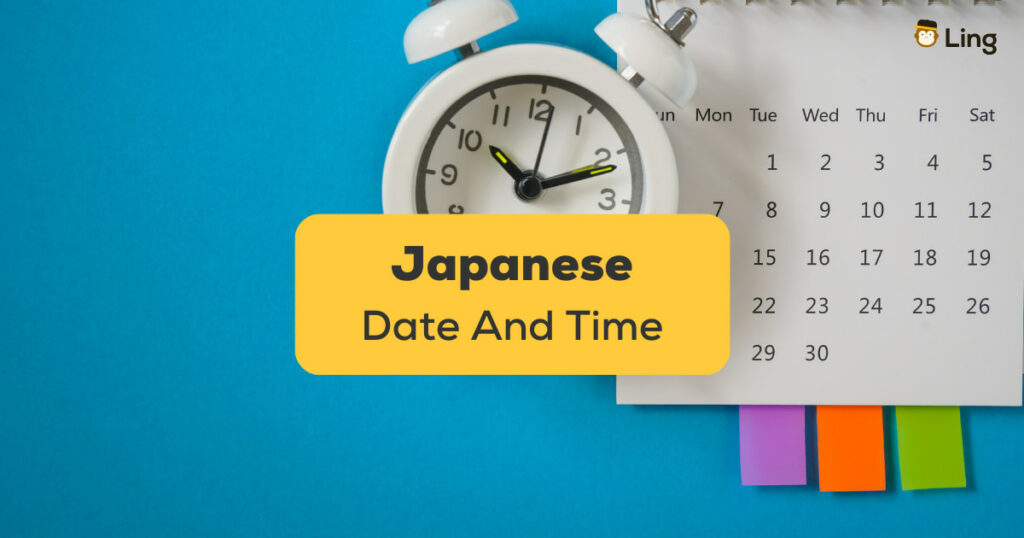In the previous post, we learned the Japanese numbers and counting system and now you may be wondering how to tell date and time in the Japanese language. This is exactly what we are going to find out today: Japanese date and time! But if you don’t know Japanese numbers yet, it would be better if you go through our previous post about Japanese numerals!
The structure of this post goes like this: days of the week, months, and years in the Japanese language. After we learn this related vocabulary, I will give you the sentence pattern and examples of telling the date. Once we dug into telling the date, we will go through telling the time in Japanese.
Alright, if you are ready to learn Japanese, let’s get started!
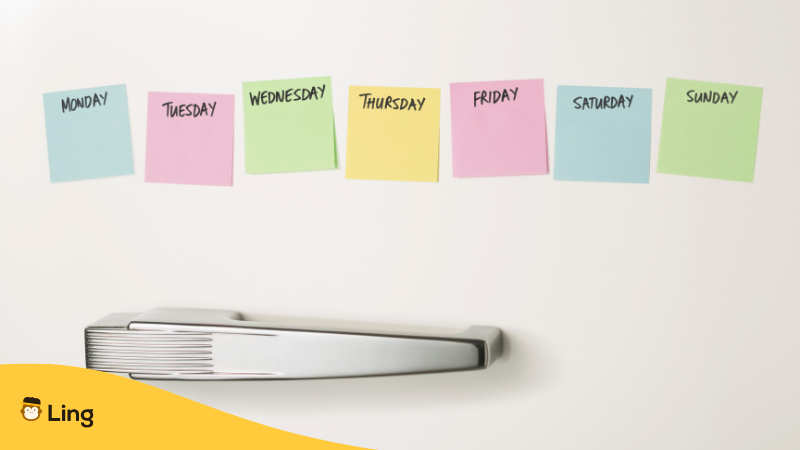
Japanese Date And Time: Days Of The Week
I think it is kind of easy to memorize Japanese dates and time especially the days of the week since they all end with 曜日 (yōbi). We also added some words at the end that could be useful, especially when telling the dates in a form of year/month/days of the week.
Example:
- 今日は何曜日ですか?(Kyō wa nan yōbi desu ka?) – What day is it today?
- 月曜日です。(Getsuyōbi desu.) – It’s Monday.

What Are Japanese Months?
In Japanese, 月 (gatsu) means month. I can say that Japanese people used a basic system to name months. The rule is simple: name them with numbers in order until 12. So, first, write the number corresponding to that specific month, then add the kanji 月 gatsu. Let me give an example for January.
January is the first month of the year, so it is 1月 (いち がつ) ichigatsu.
Now, let’s have a look at all of the other Japanese months here:
Days Of The Month In Japanese
Unfortunately, I can’t say that there is a specific order in this list, yet most of them end with 日 (nichi). Memorizing these days of the month will make you more fluent when identifying a specific date in the Japanese language.
Let’s learn more about Japanese date and time starting with the days of the month:
- 1日 tsuitachi 1st
- 2日 futsuka 2nd
- 3日 mikka 3rd
- 4日 yokka 4th
- 5日 itsuka 5th
- 6日 muika 6th
- 7日 nanoka 7th
- 8日 yōka 8th
- 9日 kokonoka 9th
- 10日 tōka 10th
- 11日 jūichinichi 11th
- 12日 jūni-nichi 12th
- 13日 jūsannichi 13th
- 14日 jūyokka 14th
- 15日 jūgonichi 15th
- 16日 jūrokunichi 16th
- 17日 jūshichinichi 17th
- 18日 jūhachinichi 18th
- 19日 jūkunichi 19th
- 20日 hatsuka 20th
- 21日 nijūichinichi 21st
- 22日 nijūninichi 22nd
- 23日 nijūsannichi 23rd
- 24日 nijūyokka 24th
- 25日 nijūgonichi 25th
- 26日 nijūrokunichi 26th
- 27日 nijūshichinichi 27th
- 28日 nijūhichinichi 28th
- 29日 nijūkunichi 29th
- 30日 sanjūnichi 30th
- 31日 sanjūichinichi 31st
Example:
- 今日は何日ですか? Kyō wa nan nichi desu ka? (What is today’s date?)
- 今日は16日です。Kyō wa jūrokunichi desu. (Today is the 16th.)
What Are Years In Japanese?
Japan has a different system for counting the years. Basically, the year starts over again from 1 at the beginning of each new reign, along with the name of the era. For example, the 平成 (Heisei) era began in 1989, so the year 2009 would be 平成21年.
If you live in Japan, it is better to know the year based on the current era. Below are the eras going back about 100 years. There are also online converters or charts about years in the Japanese calendar. Here is the list of the last 5 years with eras in Japanese. Check out some of this vocabulary for Japanese date and time:
- 2018 平成30年 year 30 of the Heisei era
- 2019 平成31年 year 31 of the Heisei era (From January to April)
- 2019 令和1年 year 1 of the Reiwa era (From May to December)
- 2020 令和2年 year 2 of the Reiwa era
- 2021 令和3年 year 3 of the Reiwa era
- 2022 令和4年 year 4 of the Reiwa era
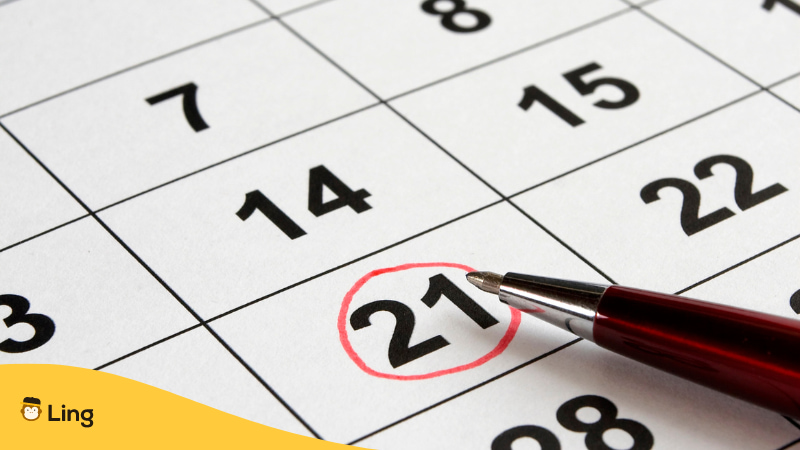
Japanese Dates
The date format in Japanese is year/month/day. Japanese words meaning “year, month, and day” are placed after the numbers. The weekday is usually abbreviated to a single character, like 水 instead of 水曜日 which means Wednesday, but may also be written in full with parenthesis. Here are all the possible date formats you may encounter in the Japanese language.
To express dates in written form you must use specific counters, so here are the Japanese counters for the day, month, and year.
- 年 (ねん) nen – Year counter
- 月 (がつ) gatsu – Month counter
- 日 (にち) nichi – Day counter
Example:
- 2009年12月24日 = 2009/12/24
- 2010年4月1日(木曜日)= Thursday, April 1st, 2010
- 昭和56年11月30日 = 1981/11/30
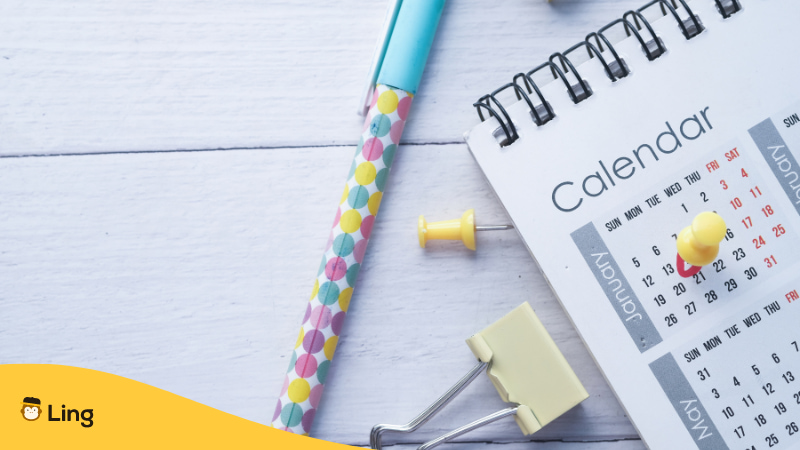
Japanese Calendar
It is vital to also know the Japanese calendar if you want to be familiar with Japanese dates and times. In Japan, the commonly used calendar is the Japanese imperial calendar as well as the Gregorian calendar.
The Japanese imperial calendar is the one we talked about above. Basically, it is a calendar unique to Japan that is based on the reign of each emperor. The year starts over from 1 at the beginning of each new reign, along with the name of the era. The new era begins when the current emperor accedes to the throne, and if you are wondering, the current era is 令和 (Reiwa), which began in 2019.
The Gregorian calendar, on the other hand, is the calendar used by most of the world and it is based on a solar dating system.
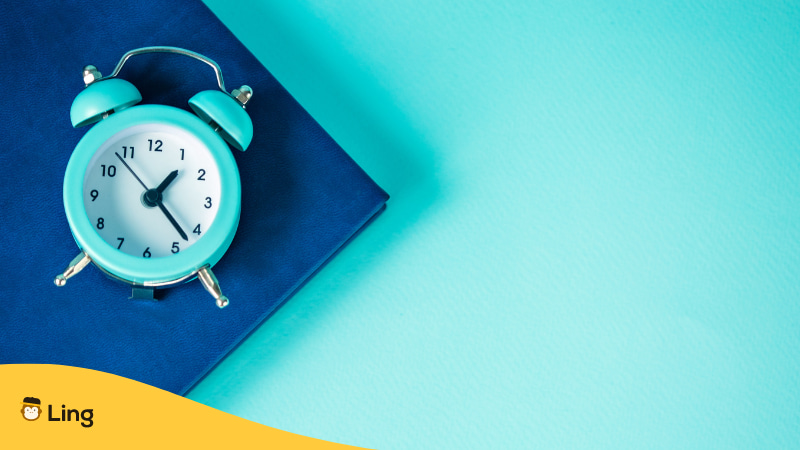
How To Tell Time In Japanese?
Japanese commonly uses the 24-hour clock for all official listings, such as plane and train schedules. In order to adapt to the 24-hour system, you should keep on counting after 12 for every hour afternoon on the clock. Like, 1 pm would be 13, 2 pm is 14, and so on. Here are the Japanese hours up to 12.
| English | Kanji | Romaji |
|---|---|---|
| 1 o’clock | 1時 | ichi-ji |
| 2 o’clock | 2時 | ni-ji |
| 3 o’clock | 3時 | san-ji |
| 4 o’clock | 4時 | yo-ji |
| 5 o’clock | 5時 | go-ji |
| 6 o’clock | 6時 | roku-ji |
| 7 o’clock | 7時 | shichi-ji |
| 8 o’clock | 8時 | hachi-ji |
| 9 o’clock | 9時 | ku-ji |
| 10 o’clock | 10時 | jū-ji |
| 11 o’clock | 11時 | jūichi-ji |
| 12 o’clock | 12時 | jūni-ji |
| 7:15 | 7時15分 | shichi-ji jūgo-fun |
| 11 a.m. | 午前11時 | gozen jūichi-ji |
To express the time in Japanese, again, we need counters. Here are the counters that you can use when telling the time.
- 時 (じ) ji – Hour counter
- 分 (ぶん) pun – Minute counter
- 午前 (ごぜん) gozen – AM
- 午後 (ごご) gogo – PM
- 半 (はん) han – Half
Example:
- 今何時ですか?Ima nan-ji desu ka? (What time is it?)
- 11時15分です。Jūichiji jūgo-pun desu. (It’s 11:15.)
Learn Japanese With Ling App!
If you want to learn Japanese from scratch, The Ling app is one of the best apps for you!
The Ling app is a language learning app that offers 60+ other foreign languages. It is a platform designed to help beginners discover new foreign languages they want to learn. Moreover, it has many features, from fun mini-games and comprehensive lessons to entertaining activities. And the best part is that you can try it out right away just by downloading it from the App Store or Play Store!
So, what are you waiting for? Install the Ling app now and start to learn Japanese.
Updated by: Gwyn
